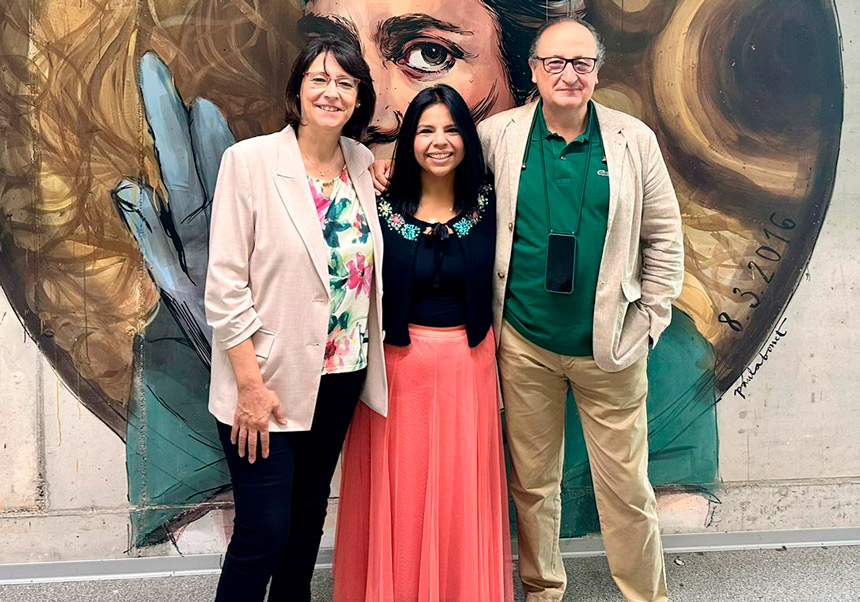Users
Social media
- More details here...
- Address
Parc Científic de la Universitat de València C/
Catedrático Agustín Escardino, 9
46980 Paterna (Valencia) Spain - Email:
iu.i2sysbio@uv.es - Phone:
(+34) 963544810
- Address
Links
Mariana Reyes-Prieto defends her thesis on minimized genomes of insect endosymbionts

Investigation & Education
Thesis
Mariana Reyes-Prieto defends her thesis on minimized genomes of insect endosymbionts

This thesis, directed by Rosario Gil and Andrés Moya, proposes a broad analysis of minimized genomes of insect endosymbiotic bacteria that illuminate a diversity of genomic, evolutionary and metabolic properties of these ancient obligate endosymbionts. Part of the results have been published in the journals Environmental Microbiology, Frontiers in Microbiology, Database and Biology. The thesis was defended on September 21, 2023.
In recent decades, symbioses between insects and bacterial endosymbionts have been the subject of notable empirical studies. Models of symbiosis between specific bacterial lineages and their hosts have been described, but large-scale analyzes have not been performed to begin to decipher the global evolutionary trajectory of the endosymbiosis phenomenon. Insects represent about 85% of animal diversity, and about 60% maintain symbiotic relationships with microbes, which primarily allow their hosts to live in niches that would otherwise be unavailable to them by providing them with nutrients, protection, and even new forms of energy. Bacterial endosymbionts typically live inside specialized insect cells called bacteriocytes. They typically have a base compositional bias toward A+T in their genomes, undergo genomic shrinkage, and have accelerated sequence evolution, all attributes convergent with organelles that resemble their extended and combined evolutionary histories. Thus, in this thesis entitled "Towards minimal cells and beyond, the development and application of bioinformatic tools for large-scale genomic data analysis of endosymbiotic bacteria of insects", the term "symbionelles" has been proposed for the long-term obligate bacterial endosymbionts of insects. Most of these organisms have the smallest genomes found in nature. This makes them good models for studying minimal cells through genomic and metabolomic analyses. Recent technological changes have forced us to look for new and creative ways to manage and process large amounts of data. With completely sequenced and annotated genomes of insect endosymbiotic bacteria, databases are indispensable tools for organizing and easily accessing specific biological information. This work offers a publicly accessible composite database that includes genomic data of symbiotic relationships between bacteria and insects, as well as all symbiotic relationships found in primary databases. This database includes confirmation of symbiotic relationships, associated publication, organization and availability of the sequences of all genes, genomes and orthologs of each prokaryotic symbiont, and the metabolic network of all organisms included in this repository as a new reaction-based methodology applied on genomic data to create collapsed metabolic diagrams. By comparing these metabolic networks based on reactions with those based on metabolites, it was possible to observe the differences and similarities between organisms that have evolved in different ways.
Mariana Reyes-Prieto carried out her doctoral research in the Evolutionary Genetics group under the supervision of Rosario Gil and Andrés Moya, professors at the Department of Genetics (Universitat de València) and researchers at the Institute of Integrative Systems Biology I2SysBio (UV-CSIC) and the Joint Genomics and Health Unit (Fisabio-UV). During the development of the thesis, Mariana Reyes-Prieto spent a stay at Trinity College (Dublin) and enjoyed a contract within SYMBIOMICS, a Marie-Curie Initial Training Network, as well as a scholarship from CONACYT (Mexico). The examining board was made up of Amparo Latorre (UV), Giuseppe D'Auria (Fisabio) and José A. Castro (Universitat de les Illes Balears), who rated the thesis as outstanding.


